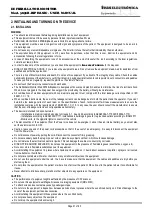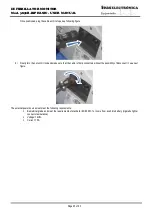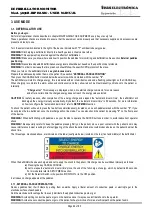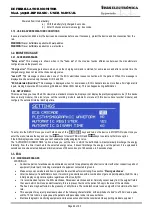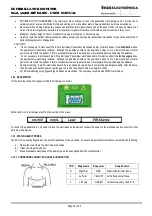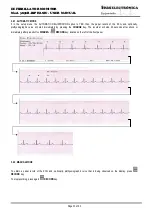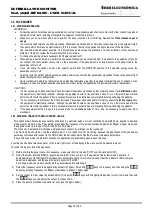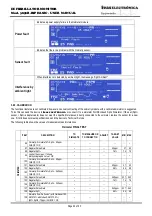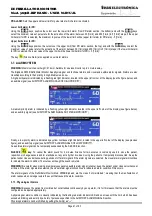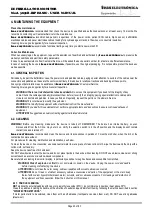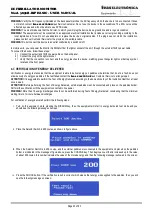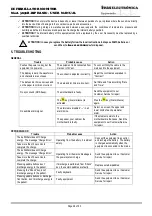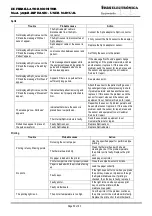
DEFIBRILLATOR MONITOR
Mod. 3850B-BIPHASIC - USER MANUAL
Page 35 of 63
3.5. PACEMAKER
3.5.1. WARNING MESSAGES
WARNINGS
•
Conductive parts of electrodes and associated connectors for applicable parts shall not contact with other conductive parts of
equipment (metal part), including metal parts of equipment connected to ground.
•
Make sure you know where and how to position the pacer electrode for monitoring. See section Transcutaneous pacer
usage.
•
It is recommended to place the ECG electrodes, Pacemaker electrodes and/or Oximetry sensor away from the surgical field in
the case in which it will use an electrocautery; this is to prevent burns on the patient’s body in the area of the electrode.
•
Use demand mode whenever possible. Use asynchronous mode when the presence of motion artifacts or other sources of
artifacts, of the ECG, render the R-wave detection is not reliable.
•
To change the pacing mode is necessary that the pacemaker is off.
•
When pacing in demand mode is performed, the patient cable must be connected from the patient to the equipment. If you do
not connect the cable patient cannot turn on the pacemaker. If the pacemaker is on and disconnect the patient cable, the
pacemaker will turn off.
•
If you will shock the patient, at move the selector switch from the MONITOR position to the selected energy value, the
pacemaker will turn off.
•
Carefully route the patient cables, extension cables, oximetry sensors and/or pacemaker electrodes to reduce the possibility of
patient entanglement or strangulation.
•
Verify mechanical capture by radial pulse when electrical stimulation (pacing) is applied. Consider the use of sedation or an
analgesic, in case the patient experiences discomfort or pain during the application of electrical stimulation (pacemaker).
CAUTIONS
•
It is not necessary to disconnect the ECG electrodes, Pacemaker electrodes and/or Oximetry sensor for defibrillation since
the equipment is electrically isolated; although the paddles should not be positioned close to or on the electrodes or metal
parts in contact with the patient, if this is not possible remove the electrodes or metal parts before positioning the paddles.
•
It is not necessary to disconnect the ECG electrodes, Pacemaker electrodes and/or Oximetry sensor for electrosurgery since
the equipment is electrically isolated; although the paddles should not be positioned close to or on the electrodes or metal
parts in contact with the patient, if this is not possible remove the electrodes or metal parts before positioning the paddles.
•
If the pacemaker function is used in demand mode for extended periods of time, may be necessary to apply new ECG
electrodes.
3.5.2. WARNING TRANSCUTANEOUS PACER USAGE
This option allows transcutaneous cardiac stimulation by electrical pulses, current controlled fixed-width 20ms, applied in demand
mode or asynchronous mode. The operator may adjust the frequency of the pulses between 40ppm and 180ppm in 5ppm steps, and
the applied current in a range of 10mA to 200mA in 5mA steps.
The connector is polarized, which makes it impossible to connect, by mistake, in other connector.
In demand mode, should be used the patient cable of 3 or 5 leads for ECG monitoring, because the application of the pacemaker
pulse is synchronous with respect to the QRS. Select the derivation which has the R waves more easily detectable.
In asynchronous mode, it is indistinct because the application of pacemaker pulses is asynchronous.
If your device has transcutaneous pacer, in the lower right corner of the display is the menu section dedicated to pacer.
To connect the pacer, follow the sequence:
1)
Before starting the pacer connection sequence, make sure that it is turned off (OFF over the options On/Off).
2)
Select the mode; demand (DEM) or asynchronous (ASY), when you turn on the equipment the default mode is demand. In
demand mode verify that the QRS complexes are detected correctly, for which can be seen that the indicator of QRS complex
detection is displayed, and the beep is heard in sync with the QRS.
To change mode, you need to shut down the pacemaker before selecting it.
3)
Select the frequency value to be applied (by default, is 70ppm): Scroll with
keys to Frequency and then using the
keys may increase frequency to 180ppm or decrease to 40ppm in 5ppm steps.
4)
Set the current to a low value (by default, 20mA): Scroll with
keys with the highlighted portion (cursor) to mA and then with
the
keys you can adjust the current in steps of 5mA.
5)
Place the pacer’s electrodes in position a) or b) (see the figure below).

